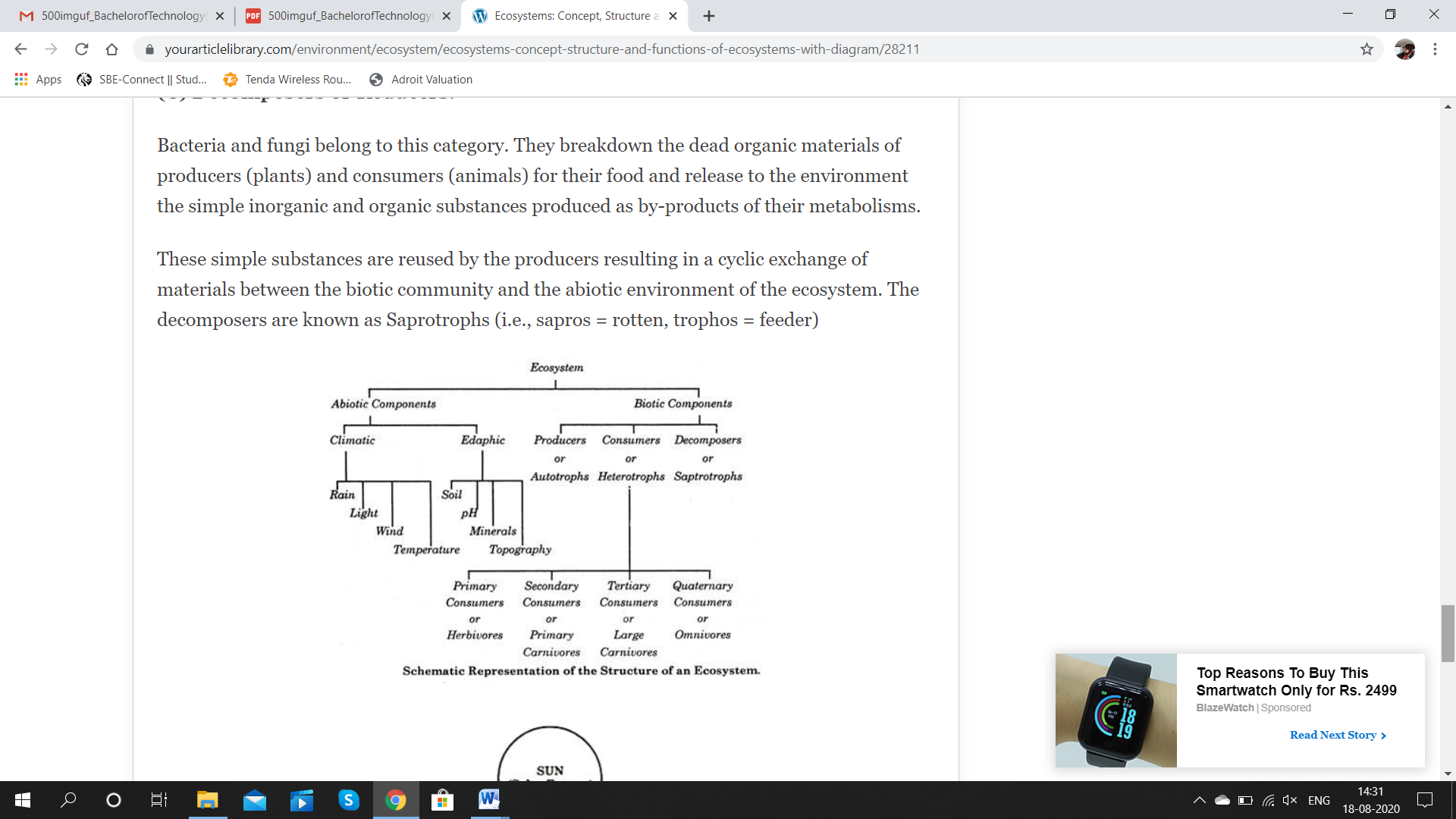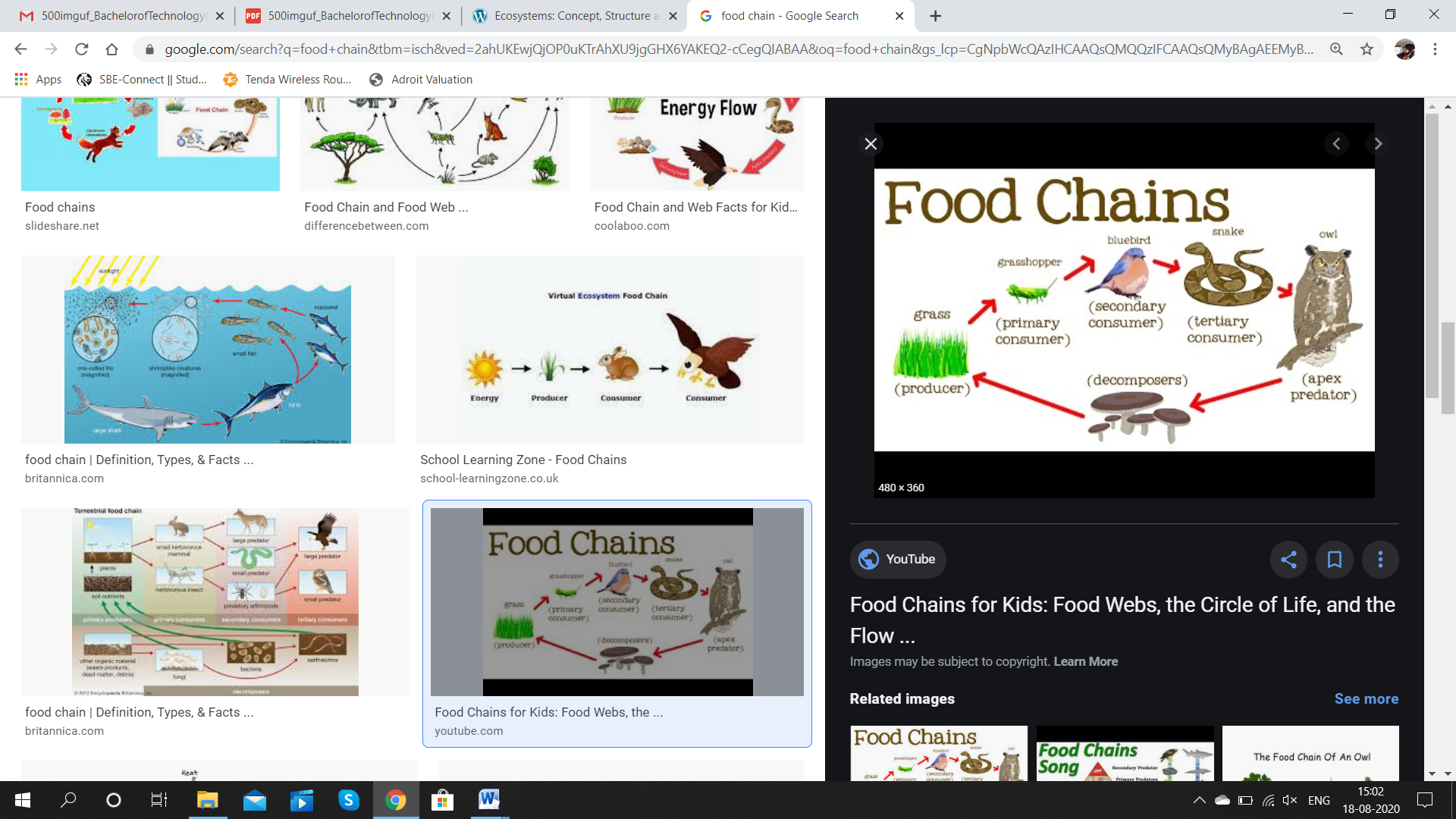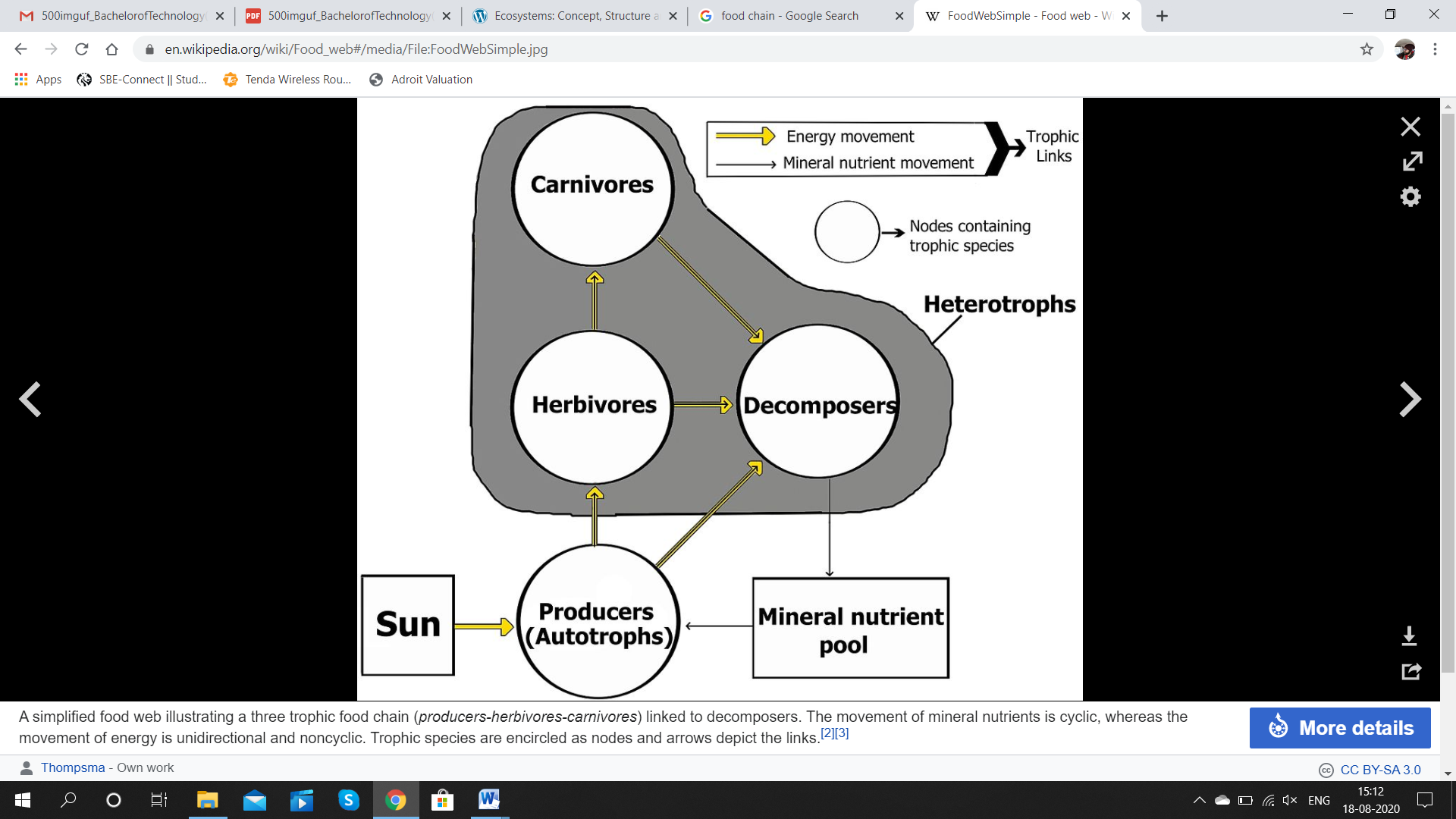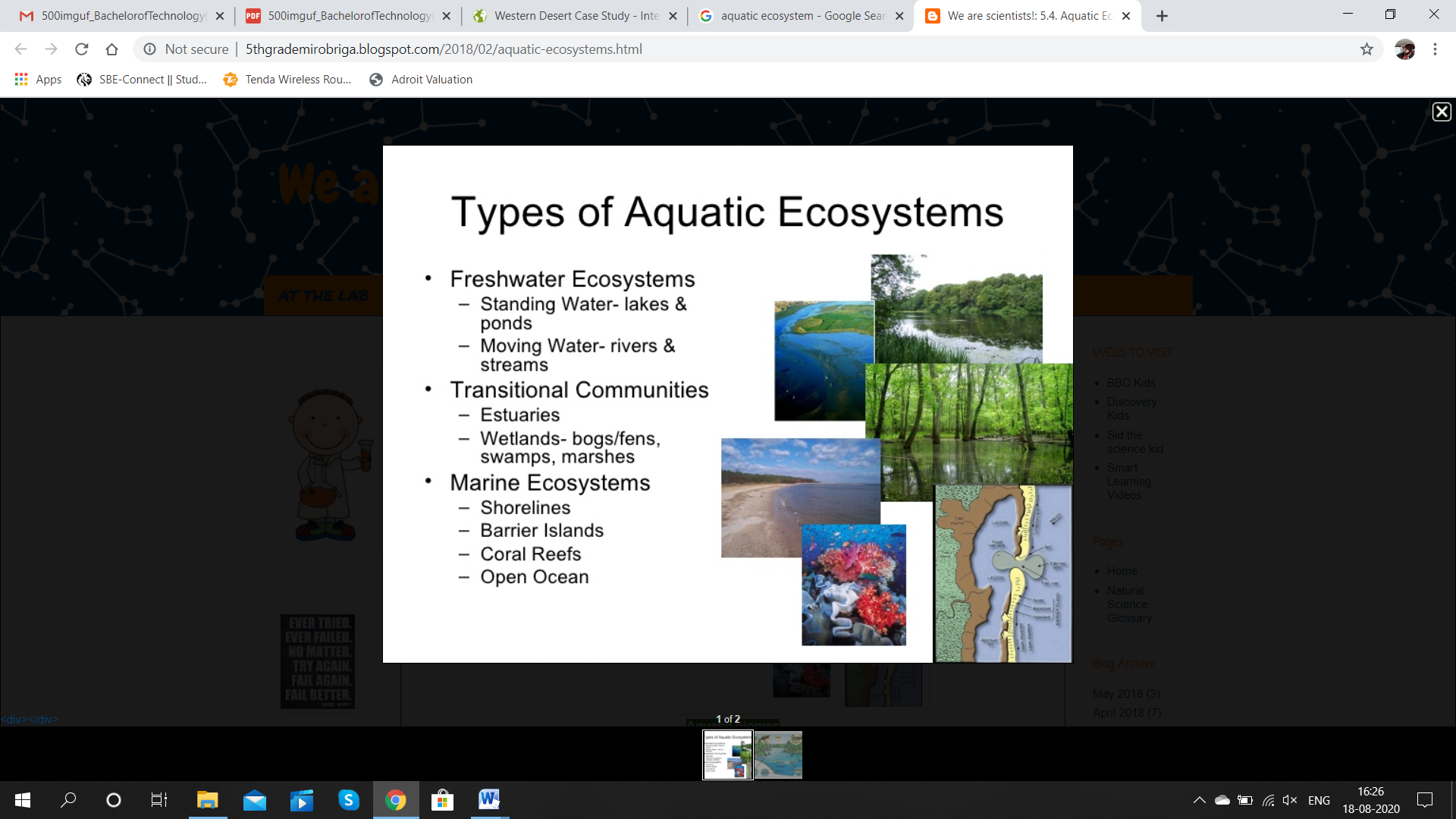Unit 2
Ecosystems
Term ‘Ecosystem’ was tossed in the year 1935 by an English Botanist- A.G. Tansley.
An ecosystem is a geographic area which contains both Biotic as well as Abiotic factors and their interaction with each other.
There are various types of Ecosystems such as:
- Terrestrial
- Aquatic
- Desert
- Grassland
- Forests
- Marine
- Freshwater, etc.
Ecosystem has 02 major components:
1) Biotic (Living)
2) Abiotic (Non- Living)
These 02 components when interacts with each other in a system, then give rise to an ecosystem.
Biotic Components are of 03 further types:
1) Producers: They prepare their own food and initiate the cycle.
Example: Plants prepare their own food with the help of photosynthesis.
2) Consumers: These are primary (who feeds on producers) & secondary (who feed on both producers and primary consumers)
Example: Herbivores & Carnivores
3) Decomposers: Feeds on dead of lifeless residues of producers and consumers.
Example: Bacteria, Fungi, etc.
Abiotic Components are of 03 sorts:
1) Climatic Factors (Rain, Lightning, Humidity, Wind, Temperature, etc.)
2) Edaphic Factors (Soil based factors such as pH, minerals, etc.)

Fig2.1 Classification of Ecosystem and its components
Basic function of ecosystem is merely an exchange of energy and nutrients in the food chain which impacts the survival of existence of all life forms. This exchange is responsible for the setting up of equilibrium between biotic and abiotic components.
The flow of energy takes place through controlled and balanced processes such as:
1) Food Chains:
Food chains were first introduced by the African-Arabic scientist and philosopher Al-Jahiz in the 9th century but got popularized by Charles Elton in the year 1927.
It is defined as an order of living organisms in a community in which continuous consumption of one organism by other organism and so on takes place.
It can be stated as a chain of organisms in their natural surroundings, through which energy is transferred.

Fig 2.2 A typical Food Chain comprises of producers, consumers and decomposers.
2) Food Web:
A food web may be defined as a graphical representation depicting interconnection between various food chains.
.

Fig 2.3 Simplified Food Web depicting energy movemet and nutrient flow between 03 basic food chain components (Carnivores, Herbivores & Decomposers)
As a food web contains a number of interconnected food chains, hence it results in a complex structure.
Whenever various food chains form such a structure by overlapping each other, it results in generation of a Food Web.

Fig.2.4 A complex food web
a) Forest Ecosystem
b) Grassland Ecosystem
c) Desert Ecosystem
d) Aquatic Ecosystem
a) Forest Ecosystem:
A terrestrial environment consisted and dominated by trees growing in a closed system is called as a forest.
So, a scientific study of interrelated processes, patterns of flora, fauna and their surroundings in a forest is stated as Forest Ecosystem.
- Case: Chunati Wildlife Sanctuary (CWS), Bangladesh
Forest Resource Collection is the significant employment choice for larger part of the individuals living in or around the Chunati Wildlife Sanctuary (CWS), Bangladesh.
The study helped to identify the nature and sorts of forest resources, their collection and quantification in order evaluate the value of the amount of forest resources collected by different resource collectors. Market based approach was being used to estimate the value of the collected resources. Interviews of the resource collectors and multiple checking of the selling price of that particular resource from the adjacent local markets was criteria used for it
A total of 28 forest trails (used by the local communities as entry or exit points for forest resource collection) out of 56 were selected proportionately from two forest ranges (12 from Chunati and 16 from Jaldi) and from all categories of forest trails based on frequency of use (heavily used, moderately used and less used) for the study.
The survey was conducted during the dry season (October to May) as it is found to be suitable for resource collection compared to wet season (June to September).
Result of the study shows that 481 resource collectors per day enter into the CWS through surveyed trails before noon and get back before evening of which 22% are female. Higher numbers of resource collectors were found to carry fuel wood (30%) followed by NTFP or fruits (13%), timber (11%), agricultural products (11%), bamboos or bamboo shoots (10%), sungrass (10%), etc.
The mode of carrying forest resources was by shoulder load (63%) followed by head load (30%). Among the resource collectors 84% are adult and the rest 16% are minor. The resource collectors spend 5.71 hours per day on average at the forests to collect resources and travel 6.41 km on average for each visit to the CWS.
The average value of the resources collected by each collector on each visit is BDT 301 (USD 3.71) which may be calculated as BDT 289,735 (USD 3,697.16) for the whole of CWS per day.
The findings of this study will give a better insight to the problem of forest degradation in Bangladesh and particularly in the CWS.
b) Grassland Ecosystem
A grassland ecosystem is one which is dominated by non woody (herbaceous) plants and various types of grass.
- Case: Grassland of Middle South Inner Mongolia
In this study, we analyse the changes of indicators of ecosystem services and functions, in order to understand the main cause of grassland degradation due to climatic variation or land use changes in the middle-south Inner Mongolia.
The soil nutrient and the water supply of supporting service got recovery during 1988–2008. The loss of net primary production declined, and the quality of the retained unconverted grassland (RUG) even increasingly degraded from 2000 to 2008.
Analytical results show that environmental degradation on the land-use-changed-area is lower than that on the RUG from 2000 to 2008. It illustrates that climatic variation has more negative impacts on grassland ecosystem service, and which is significantly higher than the so-called “overgrazing” induced grassland degradation.
Moreover, it cannot be excluded that those species died out on the RUG due to natural selection or competitive evolution in an evolutionary process under the deteriorative weather condition rather than overgrazing.
The positive impacts of human activities such as conservation programs and wildlife protection laws also benefit to regional grassland ecosystem obviously in the study area, so that can delay the environmental degradation even if each planet has its life cycle.
It indicates that an integrated regional planning involving the considerations of climatic conditions, geographical characteristics, socioeconomic factors, and ecological functions and biodiversity can benefit to regional grassland conservation based on monitoring and management via scientific methods
c) Desert Ecosystem:
A desert is a barren land of landscaping area with very little precipitation (rain), lack of vegetation and very hostile living conditions for plant and animal life.
Case: The Western Desert, USA
The western desert covers an area of over 2 lacs sqkms in south-west USA.
It has 03 sub-deserts: Mojave, Chihuhuan and Sonoran.
It extends in the states of Arizona & California (USA) and some parts of New Mexico too.
Major Extractions done in this region are: Coal, Copper, Uranium, etc.
Due to its solar potentiality, it has a huge capacity to generate solar electricity.
Some oil reserves are also found here.
Peppers and grapes are few farming crops found in this region.
With around 30 million tourists per year, tourism is a key indicator of its economy.
Some challenges that are being faced in Wester Desert are as follows:
Extreme Temperature
Inaccessibility due to its vastness
Inadequate water supply
Very low rainfall
Hoover Dam, constructed on Colorado River is playing a crucial resource for counteracting irrigation and drinking problems.
d) Aquatic Ecosystem
‘Aqua’ means ‘water’. Hence, an ecosystem present in a body of water is called an Aquatic Ecosystem.
Types of Aquatic Ecosystems:
1) Freshwater Ecosystem
2) Marine Ecosystem
3) Transitional Communities

Fig 2.5 Classification of Aquatic Ecosystem
Case: Chilika Lagoon, Orissa
A Case Study on evaluating Aquatic Biodiversity and its Conservation from Chilika Lagoon, Orissa.
East Coast of India Chilika is the largest back water lagoon of India. It is a wetland of international importance. It is one of the hotspot of biodiversity in the country and some rare, vulnerable and endangered species which have been listed in the IUCN Red list of threatened animals, inhabit in the lagoon.
170 species of plankton, 61 species of foraminifera, 136 species of mollusca, 7 species of sponges, 31 species of polychaetes, 61 species of crustaceans, 4 species of sipuncula and 2 species of echinodermata are found in the lagoon.
A total of 259 species of fishes, 28 species of prawns/shrimps and 35 species of crabs are recorded from the lagoon. The lagoon serves as a paradise for millions of aquatic birds during winter season. More than 175 species of birds are available in the lagoon. There are about 18 species of mammals and one river dolphin (Irrawady Dolphin) is found in the lagoon. There are 7 species of amphibians and 30 species of reptiles found in the lagoon
e root causes of the degradation of the lagoon were
Due to siltation, shiing of the inlet channel, reduction in salinity,
Decline in sh landing, proliferation of fresh water weeds and invasive
Species, poor discharge of ood water leading to water logging in the
Peripheral land areas, unauthorized Gheri culture, encroachment of
Peripheral land of the lagoon, soil erosion etc.
e root causes of the degradation of the lagoon were
Due to siltation, shiing of the inlet channel, reduction in salinity,
Decline in sh landing, proliferation of fresh water weeds and invasive
Species, poor discharge of ood water leading to water logging in the
Peripheral land areas, unauthorized Gheri culture, encroachment of
Peripheral land of the lagoon, soil erosion etc.
It was found that the main cause of degradation of lagoon were as follows:
siltation,
reduction in salinity,
proliferation of fresh water weeds,
Unauthorized Gheri culture in the area & encroachment of peripheral land
Shifting of inlet channel
It has been suggested the ecosystem approach for integration of limited resources will promote conservation & sustainability of Chilika Lagoon.